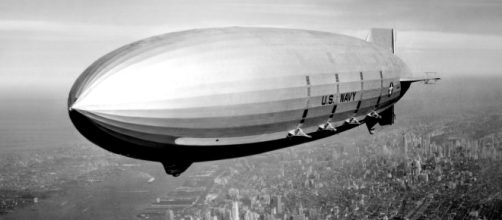Zeppelins were once thought to be the transportation mode of the future. They are similar to balloons, but not exactly the same. Zeppelins have an internal frame supporting the structure with a rigid exterior. Blimps are mostly inflatable.
During the 1920 and 1930s, zeppelins were at their pinnacle. But they would eventually become linked with tragedy and their popularity faded. Some scientists think it could be time for them to make a comeback.
In theory, they would replace cargo ships
The vast majority of traded goods can be found on a cargo ship at one point or another.
While cargo ships are impressive in their own right, they're terrible for the environment. The massive vessels expel mass amounts of carbon and require an immense amount of fuel.
Scientists in Austria have proposed an alternative, as per ZME Science. They believe zeppelins carrying more than 20,000 tons of cargo someday soar across oceans. But whether or not you support the idea, it does provide its own problems.
Unlike zeppelins in their heyday, which used hydrogen, modern blimps fly on helium. Helium is generally considered safer than hydrogen, as documented by NBC News. But helium is difficult to control. The world might also run out of it at some point, whereas hydrogen is renewable. And acquiring it might defeat the environmental purpose it would be used for.
Obtaining helium typically requires drilling that is not friendly to the environment. All things considered, hydrogen would probably be the order of the day. Technological advancements in things like exterior material would hopefully make up the safety difference.
Proponents of the zeppelin idea say they could be unmanned. As such it wouldn't be risking the safety of a crew. However, the inherent risks of having unmanned aircraft in the skies then become an issue.
There are also other potential problems, including simple practicality. The hypothetical zeppelins would be five times as long as the Empire State Building is tall. Logistics in constructing such vessels would be extremely complex. And there's also storage.
The zeppelins have to go somewhere when they're not hauling goods. And unlike blimps, they can just be folded up somewhere. Finding a parking spot for them could be a stumbling point.
Safety concerns brought an end to the zeppelin's popularity
In 1937, the international community was horrified by the news of the Hindenburg disaster. The Hindenburg had been thought to be the finest example of the luxuries of traveling by zeppelin. Many parallels can be drawn to the Titanic a quarter-century earlier.
News crews had gathered in New Jersey to cover the German airship's momentous arrival. Instead, they witnessed the ship and its flammable gas ignite and crash to the ground. The phrase 'Oh, the humanity!' would be coined from radio reporter Herbert Morrison's coverage.
At least 26 lives who'd been aboard were lost, 25 humans and one dog. A ground crewman was also killed. Even after decades, many questions still remain unanswered surrounding the disaster.
The deadliest zeppelin disaster was the loss of the U.S. Navy's USS Akron. The Akron was taken down in a thunderstorm in 1933 and sank into the ocean. It wasn't far from where the Hindenburg would go down four years later. More than 70 people were killed from the Akron. Two more died in an accident involving a blimp sent out on a rescue mission. The Akron's sister ship, the USS Macon, met a similar end off the coast of California. Two crew members were killed.


